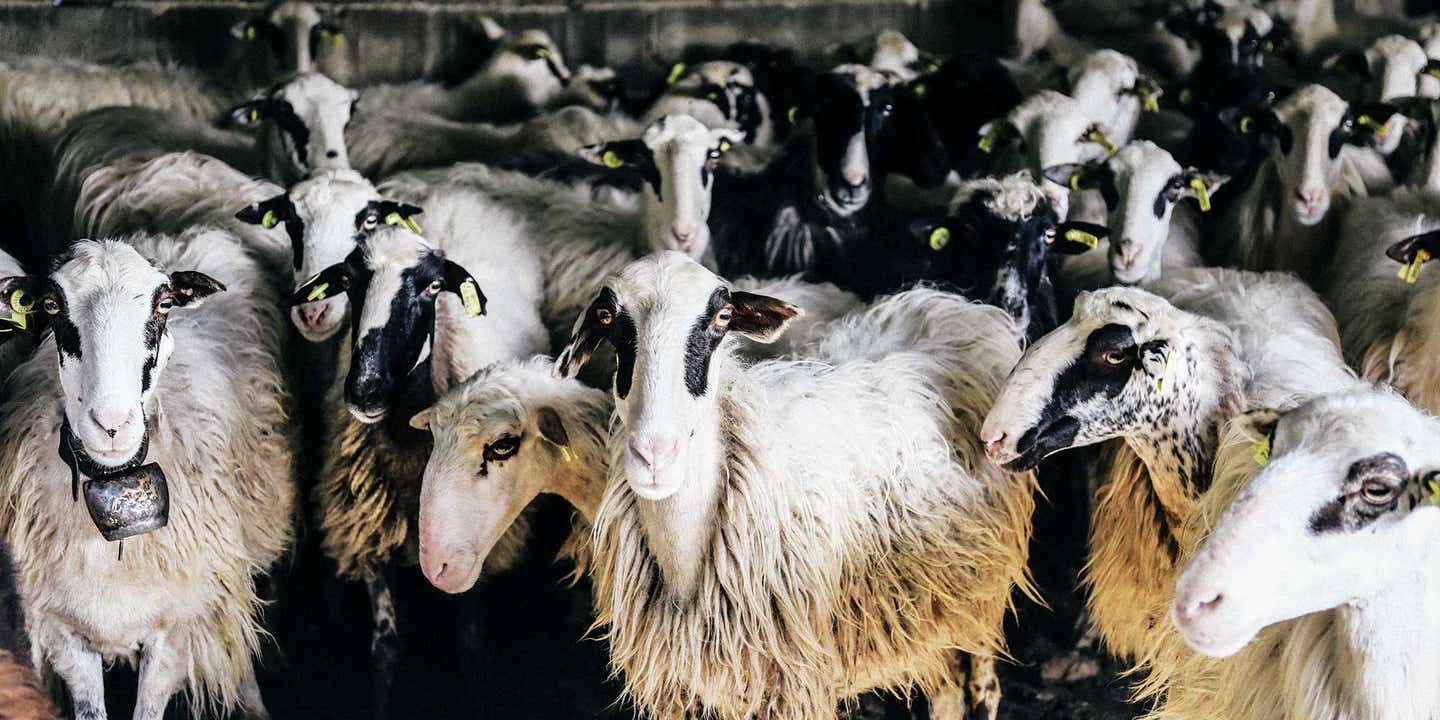
There’s No Feta in Crete
Welcome to the land of lost cheeses, where a band of shepherds and farmers resist industrialization
Stelios Trilirakis is cooking goat on one of the four woodburning stoves outside his restaurant. An hour’s drive on winding mountain roads from the western port city of Chania, the restaurant, Dounias, isn’t easy to find. Nestled in one of the many bends in the road, it sneaks up on you. You know you’re there when you see the smoke coming from the small outdoor ovens, fed by long sticks gathered from his trees that now protrude from the flames like gnarled tongues. Atop the fires are clay pots filled with frying potatoes and long-roasted goat. Trilirakis uses no electricity and cooks with the meat and milk of animals he raises and the vegetables he grows. In addition to sheep and goats, Trilirakis has one of the few cattle farms on the island. His cows are known as gidomouskara, literally “goat beef,” for the goatlike feet that are a necessity on this cliffside terrain.
Trilirakis is agile and quick and doesn’t stop moving. Now he’s at the stove, pouring fresh milk into a clay pot where cauliflower and broccoli are stewing. He stirs pots of simmering goat and adjusts the wood fire below. He darts to the garden, looking for herbs to add to the salad. Next, he’s in the open-air pavilion, across the street from his kitchen and up a set of wooden stairs. Here diners sit at simple tables, enjoying the spectacular view of the green valley leading down to Chania’s port.
Dounias doesn't have menus, so Trilirakis explains what each dish is as he delivers it to the table. There's fouriarotragos, or wild male goat, a traditional dish made by shepherds living in the mountains, the meat sizzled for hours in its own fat. Then there are potatoes fried in his homemade olive oil, so tender that they are hard to stab with a fork. He also brings out plates of vegetables, like spinach stew with manaroli or biza, a legume similar to a chickpea but with a characteristic black spot, and a potato and pumpkin boureki. Unlike the börek pastries made across most of the Mediterranean, this is a dish of layered potato and squash, topped with mizithra cheese. And there's plenty of yemista: zucchini and peppers stuffed with rice, ground lamb, and herbs.
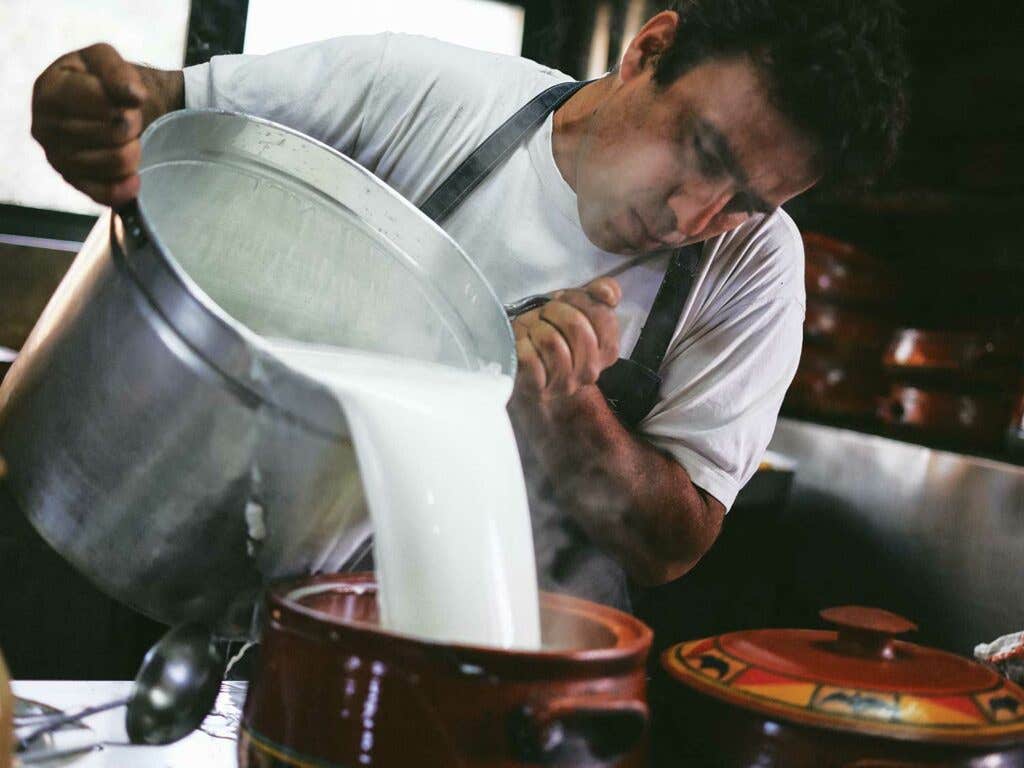
Fifteen years ago, Trilirakis left his job at a restaurant in downtown Chania to return to his village. He wanted to focus on the traditional Cretan way of cooking, which involves the slow simmering of meat and vegetables over outdoor fireplaces like the ones he’s built at Dounias. It also involves making cheese from the cook’s own sheep and goats.
In his restaurant, Trilirakis makes mizithra, a fresh and slightly sour ricotta-like goat cheese. He also makes staka, a milk product that is somewhere between cheese and yogurt. It's warmed for several hours, and when the fat and protein separate, the fat becomes a sort of butter that is perfect when spread on fresh bread. The rest is the actual staka, which can be baked into pies or added to pasta.
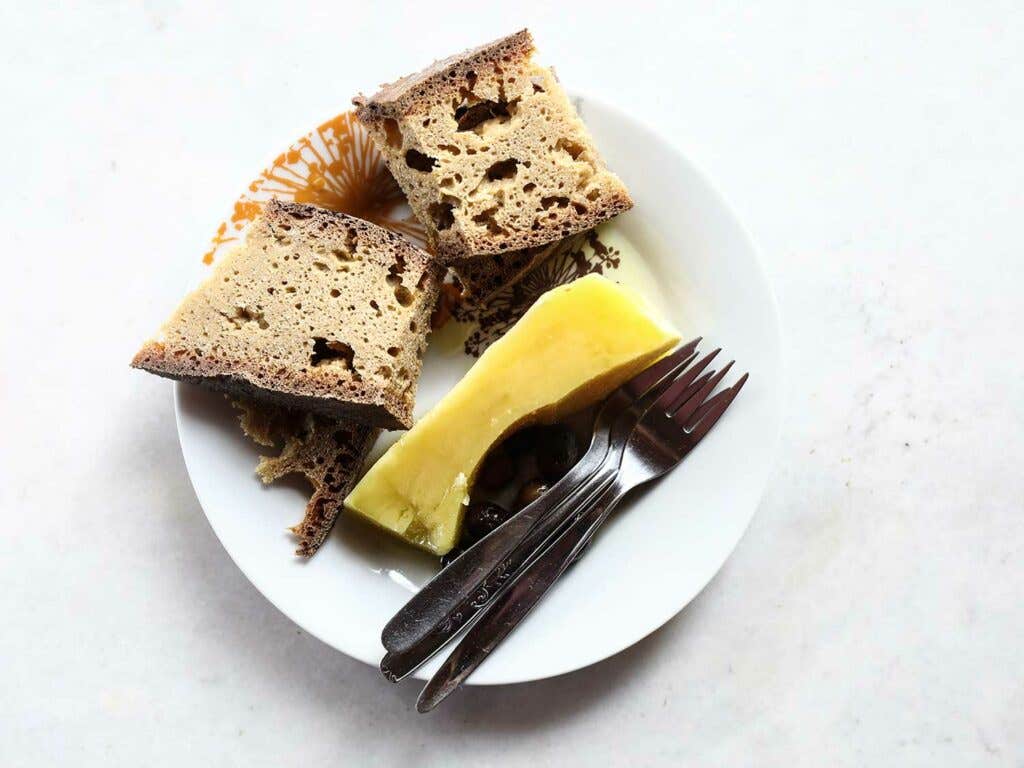
Small-scale cheesemakers like Trilirakis are increasingly rare. A decade ago, there would have been a few cheesemakers in each village, and most people from that village would know exactly who they were. They would own flocks of sheep or goats, taking them to the mountains to graze every spring when the grass started to grow. They would milk them, make the cheese, and then cart the cheese down from the mountains to sell it at local markets, or sometimes leave it to age in caves in these mountains. Now, shepherds are more likely to sell the milk from their herds to a small factory.
Many local cheeses don’t have specific names, says Clifford Wright, author of A Mediterranean Feast. “Each village may only have one cheese,” Wright says, “so they don’t need a name for it.”
One cheese that does get a name is graviera, made almost entirely of unpasteurized sheep's milk or a combination of sheep's and goat's milk, and traditionally aged in caves. Another is anthotyro, a fluffy, ricotta-like cheese that ages to become harder and better for grating over pasta. Pichtogalo is a spreadable cheese whose name means "thick milk." Anthogalo has a similar texture, almost like butter. It can go on bread, potatoes, meat, vegetables—I can say from experience that there is no food that doesn't benefit from a hearty dollop of anthogalo. Malaka, a curd cheese, is a byproduct of an early step in making graviera. It's usually used in pies because it's soft and malleable.
“This is Cretan food,” Trilirakis tells me as we finish the last bites of our meal, gesturing at his ovens, the fires still burning low, sticks protruding only slightly less than when we had first arrived. He leans in close and waves his hands. “Not moussaka, not pastitsio.”
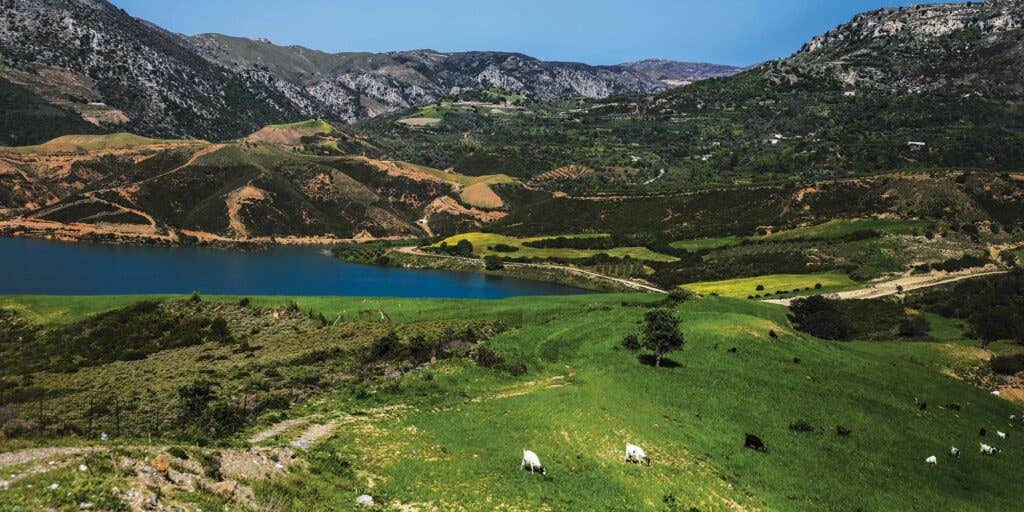
There is no feta in Crete. Ask anyone here and they’ll tell you, sometimes bitterly, sometimes with a laugh: There’s no feta in Crete because they’re not allowed to call it that. Feta is covered by a Protected Designation of Origin by the European Union, meaning its production is strictly regulated and limited to specific regions in Greece. Instead, Cretans make what they’re compelled to call “white cheese,” which is made exactly the same way and looks and tastes the same as feta. When asked why, Spyros Balantinos, a cheesemaker, says it’s because Crete isn’t really Greece. Many here see themselves as Cretan, not Greek. They’re also well known for their ornate mustaches, heavy drinking habits, and an affinity for bringing guns to most celebrations.Balantinos runs a small factory making cheese from milk he buys from a group of two dozen shepherds spread across Chania and the nearby mountains. His great-grandfather, Stelios, started the business in 1928. Behind his desk there’s a real-life shepherd’s crook, the kind you see in children’s stories. They now sell their cheese from a shop on the busiest street of Chania, and they pride themselves in making only traditional Cretan cheeses. Their graviera, for example, is PDO certified, meaning it is produced the way it was before industrialization and then aged at the same temperatures and humidity levels as you’d find in a cave. There are strict regulations determining the cheese’s size, weight, shape, and color.
Cheesemakers are slowly disappearing, and Balantinos sees two main reasons why. First, not everyone is making it legally, so they can’t sell in markets anymore. “Many people make cheese in their houses, but they don’t pasteurize their milk, so they have to be careful where they sell it,” he says. “If they get caught by the authorities they’ll get arrested.”
The other reason is that the old way of doing things meant a lot of work for little gain. “It’s not easy for the shepherds to take the cheeses from the mountains,” he says. “In the past they had to produce there, then carry the cheese down to the village to sell it. But now, they prefer to just sell the milk, which is more profitable for them.”
Balantinos does know a few shepherds who are living with their flocks in the mountains. He calls the son of one of them—most shepherds don’t bother to bring cellphones to rural areas where there isn’t service anyway—and after a few minutes of discussion, he puts the phone down. Smiling, he says, “This is why he’s a shepherd, so he doesn’t have to talk to anyone.”
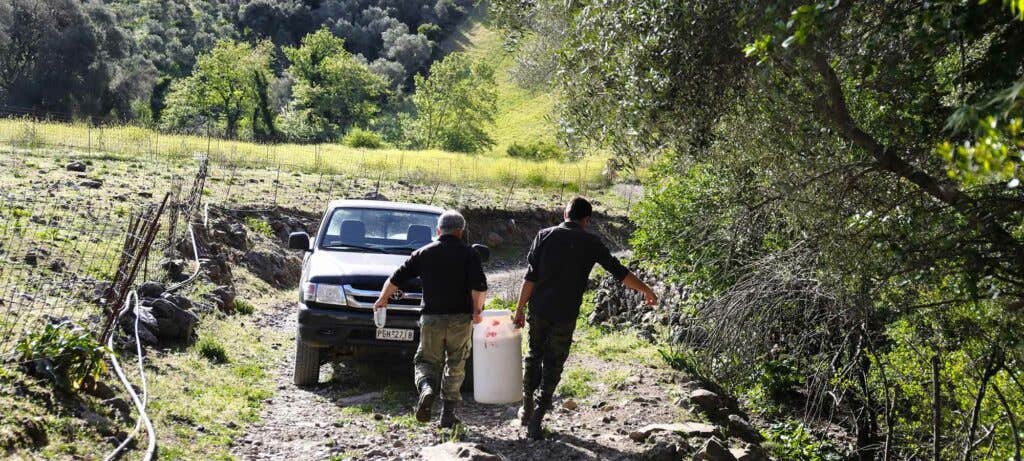
After spending almost a week searching for a shepherd who is also making cheese—a search that involves calling friends and friends of friends, stopping to ask anyone standing on the road about their local cheesemaker, and inquiring about the cheese suppliers at every single restaurant we visit—I finally find someone who is willing and available to talk. We drive to his home in Rethymno, a regional unit east of Chania, where he and his father milk their sheep and make cheese.Stelios Philipakis is in the middle of making a batch of mizithra. He got the milk from his own sheep just a few hours earlier. He first corralled his sheep into a small barn, empty except for a trough filled with feed, a temporary distraction to keep the jittery sheep still. With his father, Antonis, Philipakis pulled the sheep toward them and turned them around so that they were facing backward between Philipakis’ legs. It’s a milking method typical to the shepherds of Crete, taught in agriculture schools here but used nowhere else in Greece.
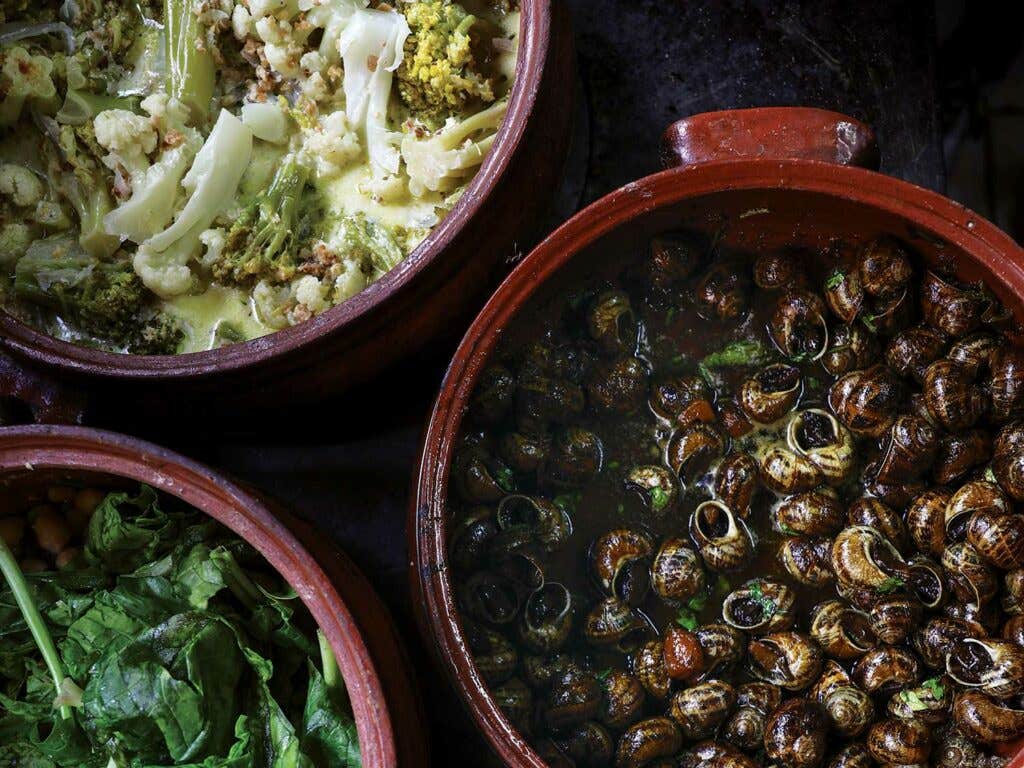
In less than an hour they had milked about 100 sheep, and their plastic jug was filled almost to the brim, 15 gallons of milk about to become cheese. Philipakis heats it in a makeshift production facility inside a cavernous room attached to his parents' house. It's all bare concrete, cool and shady, and empty except for a counter, a sink, a portable burner, and a table where Philipakis and his parents sit to eat a breakfast that eventually turns into lunch. His mother Magdalini has set bottles of water and raki, a traditional Cretan spirit, and a plate of kalitsounia, little hand-wrapped pockets of spinach and cheese, out on a watermelon-printed tablecloth. As she brings food from the house to the garage, Philipakis' father presents his best wheel of aged graviera, speckled in a pattern of tiny diamonds imprinted by the cheesecloth.
The graviera we eat, cut into sticks, isn’t aged quite as long, but it’s still a little nutty, almost like parmesan. There’s a plate piled up with anthotyro, meant for spreading on hardened Cretan rusk bread, or dakos, but I’m eating it by the forkful. It’s creamy and a tiny bit sweet, and there’s something almost grassy to it. It takes me a minute to realize this is what Cretan shepherds pride themselves on—the cheese retains some of the grassiness from what the sheep and goats eat.
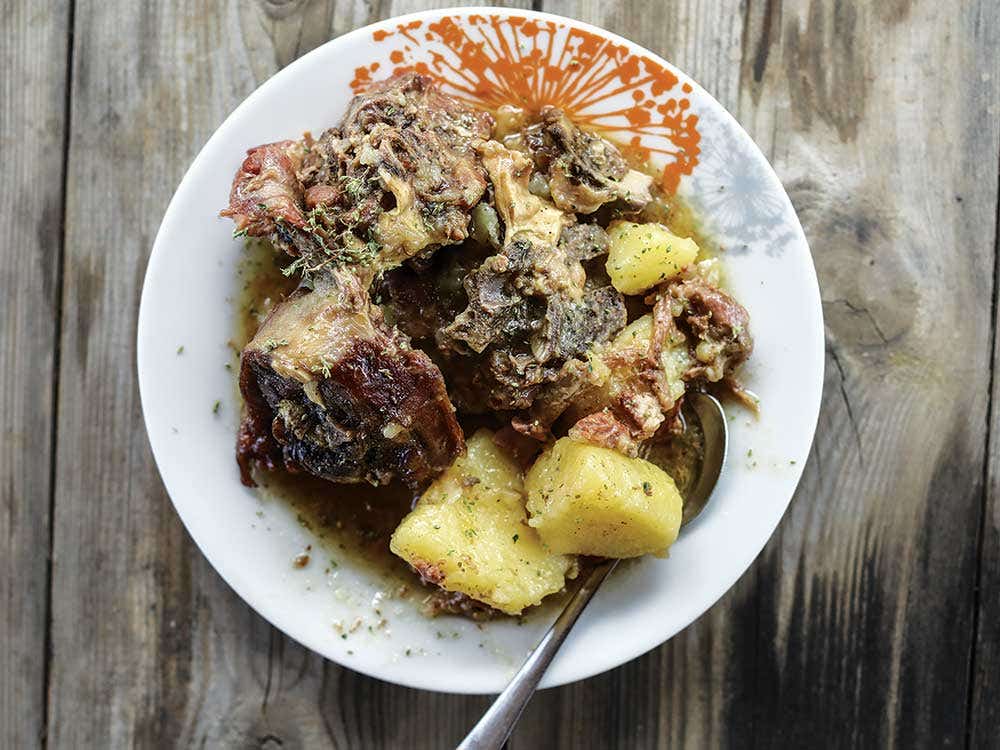
“My cheese is good, because it starts with the first and most important ingredient: the milk,” Philipakis says. He knows what his sheep are eating, so he knows how the milk should taste, and that will dictate how good the finished product will be. He’s determined to eventually have a small shop where he will sell his own cheese, made by his hands from beginning to end.
Philipakis is aware that he is a rarity in Crete, and in Greece in general. He talks about how many other 20-somethings have moved out of their villages and into cities like Athens and Thessaloniki, and how there are fewer and fewer young cheesemakers learning the traditions of their island. He says his village produces about 20 pounds of milk every day, but that almost everyone he knows sells all of it. Many don’t even know how much to charge, and they end up taking whatever they’re given simply because it’s easier.
Philipakis faces his own set of challenges in keeping traditions alive. He says he’ll need funding from the state to make his shop a reality, but right now state funding is hard to rely on in a country continuing to contend with a crippling economic crisis. The unemployment rate remains high, and Greeks even have a monthly limit on how much cash they can withdraw from their bank accounts. In a cash-driven economy, this is sometimes barely enough.
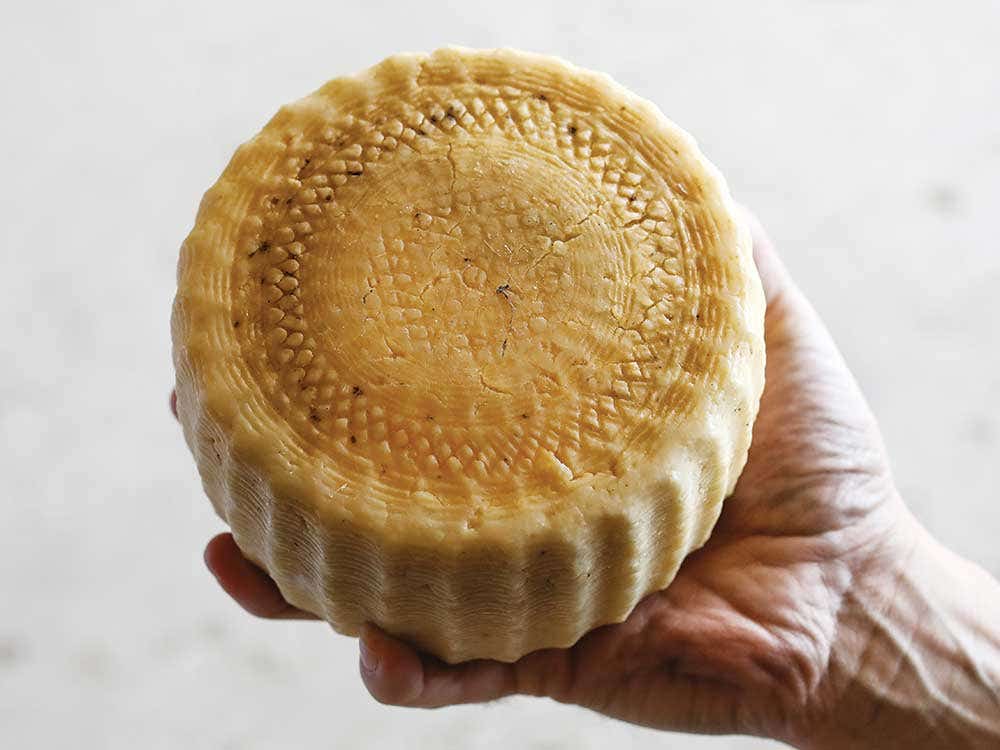
There are also the age-old difficulties in shepherding and cheesemaking. In the mountainous middle of the island, it can snow—a lot. Philipakis shows me photos of his snowbound sheep, the animals almost indistinguishable from the white cover except for their eyes and noses. He had to bring all of them inside, he says, and paid 200 euros a day for 20 days to keep them warm. But through all of this, Philipakis remains optimistic. After the snow comes this, he says, gesturing at Crete’s abundant green.
The end of the process is near, but to make sure the cheese is almost ready, Philipakis runs his long fingers through the hot yellowing water, pushing white clumps to the edges of a large metal pot and separating them from the rest of the liquid. He balls little pieces into his fist, wringing excess water out, then tastes it to see if it’s salty enough, if the milk has curdled enough. If it has, it’s time to drain the rest of the liquid. It’s getting close. He has a wooden stick wrapped loosely at one end with wire for stirring, and a colander spoon—but at this stage, Philipakis knows his hands are the best.
Eat like they do in Crete
Cretan Cheese Pies with Thyme and Honey (Kalitsounia)
These traditional Cretan handheld cheese pies are often served as an Easter treat. Get the recipe for Cretan Cheese Pies with Thyme and Honey (Kalitsounia) »
Sarikopitakia (fried mizithra cheese pastries)
These savory fried cheese pies are named for their spiral shapes. Sariki, a Turkish word meaning “turban,” is also the name of a traditional headdress still worn by Cretan men at celebrations. Get the recipe for Sarikopitakia (fried mizithra cheese pastries) »
Roasted Goat with Potatoes and Onion
Goat’s milk is used widely in local cheeses. But this simple dish from Stelios Trilirakis of Dounias restaurant represents a traditional Cretan preparation of the meat, slow-roasted for hours in a clay pot over a wood-fired oven. Get the recipe for Roasted Goat with Potatoes and Onion »
This milky vegetable casserole from Crete is sprinkled with a cracked wheat topping for a little crunch.
Cretan Bean Stew with Spinach
Dark leafy greens are the predominant vegetables in Crete, where more than 100 types grow and they are often paired with beans in sautés, stews, and pies. Get the recipe for Cretan Bean Stew with Spinach »
Keep Reading
Continue to Next Story










